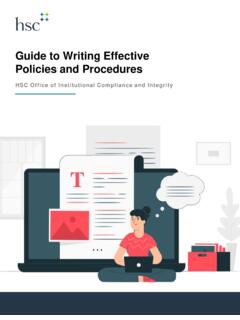Transcription of Laying the Groundwork for Successful Coaching Efforts
1 L ayi ng the G roundwo rk f o r Su cce ssf ul Coa chi ng E ffo r ts B e t h e t e a m o f c h o i c e f o r e d u c a t i o n , d i s c o v e r y a n d h e a l t h c a r e . C oac h in g P lan Guide This guide provides a framework around developing a Successful Coaching plan. The focus is on individual goals for team members that identify development and growth opportunities. After reading this guide, studying the examples provided, and completing activities, you should be able to: DEVELOP a Coaching plan that aligns individual performance with department and institutional goals. USE a variety of methods to assist with identifying development and growth opportunities. UNDERSTAND how to write effective goals and the difference between critical skills, activities and accomplishments.
2 KNOW how to use the Coaching plan as an effective Coaching tool. Scheduled Coaching Planned time for 1:1 meetings that occur on a regular basis and serve as an opportunity to level, set and refine developmental focus. One of the goals of a Coaching culture is to utilize both integrated and scheduled Coaching to create a framework for Successful Coaching Efforts . This guide is focused on scheduled Coaching and how to effectively use the Coaching plan template to ensure you are successfully Coaching your team. Scheduled Coaching sessions: Create a foundation for consistent Coaching Efforts by setting goals that help define development and growth opportunities. Ensure the supervisor s Coaching activities are supporting the team member s development goals. Help the coach know what to coach to during in-the-moment, integrated Coaching opportunities.
3 Co ac hi ng P la n G uid e Laying the Groundwork for Successful Coaching Efforts Pag e 1 The HSC Values-Based Coaching Culture will include scheduled Coaching sessions between supervisors and their team members. WHAT YOU NEED TO KNOW 3 1 2 4 These scheduled sessions will occur three times a year, and will include a formal Coaching plan template. The Coaching plan is a shared responsibility between the team member and the supervisor. Team members will initiate the plan, and supervisors will provide guidance in creating a Coaching plan that sets meaningful goals. Growth Opportunities An important element of Coaching is identifying growth opportunities for individual team members. Co ac hi ng P la n G uid e Laying the Groundwork for Successful Coaching Efforts Pag e 2 WHAT IT DOES NOT The Growth Opportunity Analysis helps us understand and create a visual picture of growth --- whether it s future goals for an individual team member, future growth of the institution, or team goals a department is aiming to achieve.
4 What the Opportunity Analysis does not do is help define how the team member will reach their future goals, or how HSC will achieve its vision: Be the team of choice for education, discovery and health care. In order to achieve this, we need to first identify how the team member wants to grow and how they need to grow to contribute and achieve the department and organizational goals. This is the role of scheduled Coaching . Identify Skills To Develop Before you begin developing a Coaching plan, you ll first need to understand a basic framework for identifying skills each member of your team needs to develop. Co ac hi ng P la n G uid e Laying the Groundwork for Successful Coaching Efforts Pag e 3 1. The framework starts with critical skills or competencies a team member needs to achieve success in their role.
5 Think of critical skills as essential functions or categories of work. Critical Skills Competencies Essential Functions Categories of Work Employee Name Most Critical Skills For This Role Strength? Development Area? 1. Communication 2. People Management John Smith 3. Project Management 4. Customer Service 5. Office Duties 3. Decide if the skill is a strength or development area. Use standards defined by your department or rely on your own professional judgment. If you re unsure, think about what you would reasonably expect of someone in this role. Employee Name Most Critical Skills For This Role Strength? Development Area? 1. Communication 2. People Management John Smith 3. Project Management 4. Customer Service 5. Office Duties 2. List three to five critical skills or competencies the team member needs in his or her role.
6 Inventory of Employee Strengths & Development Areas Before you identify the areas you need to coach, you should understand the skills your team members need to succeed in their current roles. Use the template below to record where your team members stand against the most critical skills and competencies for their roles. Co ac hi ng P la n G uid e Laying the Groundwork for Successful Coaching Efforts Pag e 4 Employee Name Most Critical Skills For This Role Strength? Development Area? 1. 2. 3. 4. 5. Employee Name Most Critical Skills For This Role Strength? Development Area? 1. 2. 3. 4. 5. Employee Name Most Critical Skills For This Role Strength? Development Area? 1. 2. 3. 4. 5. Co ac hi ng P la n G uid e Laying the Groundwork for Successful Coaching Efforts Pag e 5 ASK : Managers often fall into a habit of Coaching their team to correct performance weakness.
7 While this is critically important, it should not be the only time managers coach as it implies Coaching only occurs when a team member does something wrong. By focusing your Coaching Efforts on a team member s strengths, you reinforce positive behaviors and further develop strengths that directly benefit your team. To identify how the team member uses this skill, think about the activities they perform. Activities are actions that produce a result, and are typically described through the use of verbs. Activities for communication might include: Writes clear and concise emails Listens to other team members Encourages feedback from others Facilitates effective presentations How can you develop a strength? Current Responsibility: Facilitating presentations for the team. Challenge: Facilitating presentations for other departments or leadership.
8 By developing strengths, you are reinforcing behaviors that you want to continue, while at the same time allowing the team member to work in an area that energizes them. The result is increased motivation and satisfaction in his or her role. Coaching Should Focus on Strengths, Not Just Weaknesses Exam pl e : S t r en gt h = C om m un ic at ion How does the team member currently use this strength? How will he/she need to use it in the future to continue to grow and develop in his/her role? Strengths are usually what a team member will rely on to stand out from his or her peers and these strengths are what will push a team member s overall performance to the next level. Weaknesses, or low performance areas, should be addressed so they don t derail advancement or create a career stall, but focusing only on weaknesses is demotivating, and sends the wrong message that you aren t invested in the team member s development.
9 Career Planning Questionnaire Co ac hi ng P la n G uid e Laying the Groundwork for Successful Coaching Efforts Pag e 6 As important as it is to build strengths and development areas that a team member needs now, it is also important to build skills that he or she will need for future roles. This conversation guide is designed to ensure you have a firm understanding of a team member s career aspirations. By assuming that an individual will follow a particular career path, you risk expending effort developing skills he or she may not want or need in the future. Conversation Guide Questions to Ask Your Team Member Team Member Responses Questions About Your Current Goals What is your favorite part of your current role? What would you describe as your biggest strength? What one skill would you like to develop to improve in your current role?
10 Questions About Your Future Roles? If there is one task or project type you d like to do more frequently in your future roles, what would you select? If there is one task or project type you d like to do less frequently in your future roles, what would you select? Questions About My Role (as our supervisor) How can I best help you in your current role? How can I best help you achieve your career goals? Are there other individuals you would like me to enlist to help you achieve your career goals ( a colleague in a role you interested in pursing)? By having career planning conversations with your team members early, you not only ensure that your Efforts are focused on the right skills, but you send the message that you are invested in their long-term goals. Collaborate on Development Goals.








